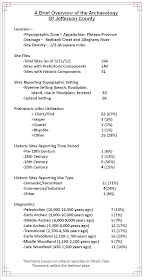TWIPA would like to thank Kenneth Burkett, executive director of the Jefferson County Historical Center, for guest blogging this
week. We continue the county by county archaeological journey with Jefferson
County.
Situated in the uplands of the Appalachian Plateau physiographic region this area consists of
rolling hills and moderately steep sided valleys covered in regrowth hardwood
forest.
Transecting the county are three major westward flowing
waterways with the Clarion comprising the northern boundary,
the Redbank Creek in the center and the Mahoning Creek near the southern
border. These waterways were important transportation routes for Native
Americans travelling between the Susquehanna and Allegheny River basins
requiring only short portages over the divide between their upper tributaries
and the West Branch. The
presence of these prehistoric inter-regional travelers is frequently found on
streamside campsites in the form of artifacts made from non-local lithics such
as jasper, rhyolite, quartzite and argillite along with an occasional steatite bowl
fragment from eastern Pennsylvania. From the west, Upper Mercer, Coshocton and
Flint Ridge lithics originated in central Ohio.
Steatite Pot from Redbank Valley
As this area is unglaciated, the primary sources of chert are
within the Pleistocene gravels of the Allegheny river and a poorer grade of
local Vanport siliceous shale also referred to by archaeologists as Jefferson
County chert (Burkett 2001). This black
and tan chert outcrops on hillsides in the central part of the county where
several prehistoric quarry sites are known. Many more probably existed prior to
their destruction by 20th century strip mining. Often found at these locations are the stone digging
picks used to expose the chert veins. Hammerstones and anvil stones are evidence
that the raw material was tested for quality and the initial shaping of the
tools began at the quarry. This process also served to reduce the weight of the
tool blanks prior to transporting them to the habitation sites. Many of the
rockshelters along the Redbank and Mahoning creeks contain enormous quantities
of chert chips produced while refining or finishing these tool blanks.
Jefferson County Chert Artifacts
Formal archaeological investigations of prehistoric
sites have rarely been conducted in this county. The only reported excavations
are the Bunny Rock Rockshelter (36Je48), the Ridge Rockshelter (36Je49) and the
Davis Rockshelter (36Je50) excavated in the Redbank drainage between Brookville
and Summerville by Ken Burkett (nd.). In addition, the Dutch Hill Rockshelter
(36Je132) near Belltown overlooking the Clarion River was excavated by Andrew
Myers (2001).
Dutch Hill Rock Shelter
Bunny rock Projectile Points
Jefferson County has an extensive 19th
century logging history and there are many remnants of mills, raceways, bracket
dams and railways found throughout the county in and along the streams and
tributaries. Annually each summer since
2005, Brian Fritz and Amanda Valko have been working at Clear Creek State Park
to present a public archaeology program where volunteers help excavate, catalog
artifacts and document a blacksmith’s shop that was part of the circa 1870’s Frazier
Sawmill complex.
Frazier Sawmill Excavation
We
hope you have enjoyed this short overview of Jefferson County and that this
will inspire an interest in recording and preserving the archaeological sites
in your community. For more information on the history of Jefferson County
visit the web site at www.jchonline.org. These resources are Pennsylvania’s
heritage and for all of us it is our window into the past. Help us to
protect and preserve these
archaeological resources which are crucial to our understanding of the past. We
encourage every citizen to take an active role in preserving our archaeological
heritage and ask that you respect these sites and Preserve our Past for the Future.
The 98th
Annual Pennsylvania Farm Show opens on Saturday, January 7th, 2013.
This year’s exhibit theme is the Archaeology of the French and Indian War
(1756-1763). We will be showcasing the State Museum’s excavations
at Fort Hunter as well as excavations at Fort LeBoeuf, Fort Augusta, and Fort
Loudoun. A brochure detailing the archaeology of this time period will also be
available. Our exhibit wouldn’t be
complete without the 20’ dugout canoe which is always an eye catching
attraction. French and Indian War period re-enactors will be present to answer
questions and tell stories. Also, this year the Bureau for Historic
Preservation’s exhibit booth will be located directly across the aisle from our
own booth, providing a united display for the PHMC.
two visitors at the Farm Show try out our dugout canoe
We are located in the Family
Living Section, on the McClay Street side, not far from the carousel and the
butter sculpture- Hope to see you there! January 5th - 12th Pennsylvania Farm
Show, 9-9 Saturday to Friday. 9-3 on Saturday 1/12th
For more information, visit PAarchaeology.state.pa.us or the Hall of Anthropology and Archaeology at The State Museum of Pennsylvania .








No comments:
Post a Comment